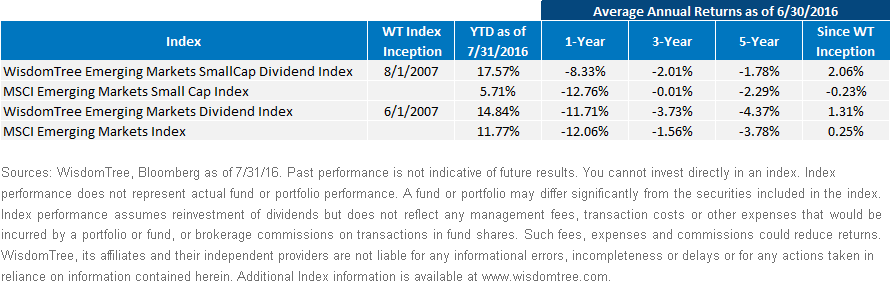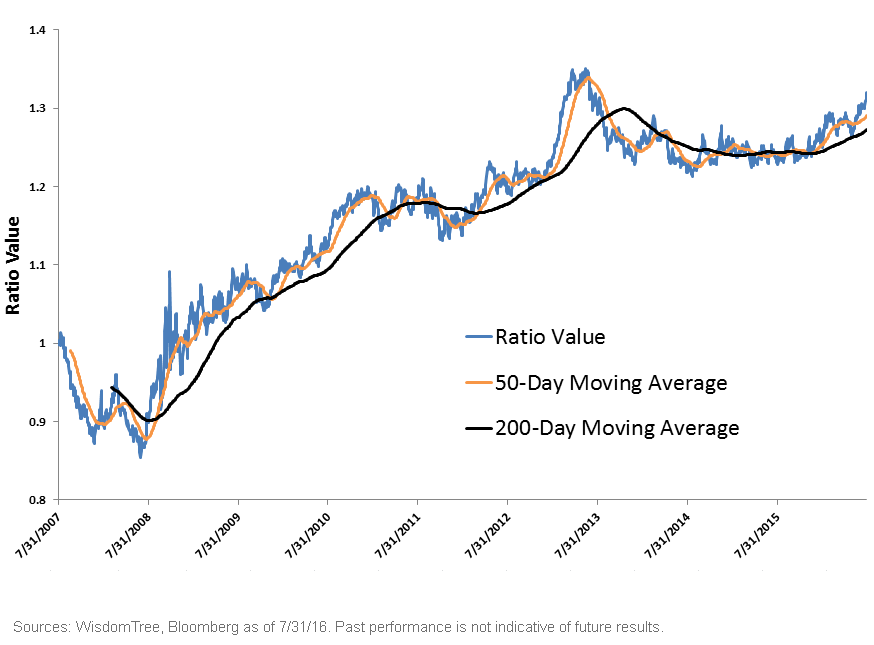Capitalizing on the Emerging Markets Rally



 The WisdomTree Emerging Markets Dividend Index, which measures the performance of nearly 1,300 dividend-paying stocks in the developing world, has outperformed the cap-weighted MSCI benchmark by more than 3 percentage points year-to-date. More notable has been the outperformance of dividend-paying small caps in the emerging world. The WisdomTree Emerging Markets SmallCap Dividend Index, for example, has outperformed the MSCI Emerging Markets Small Cap Index by nearly 12 percentage points, and it has outpaced the broader MSCI Emerging Markets Index by 580 basis points (bps) through July 31, 2016. WisdomTree created the Index and the ETF that tracks it, the WisdomTree Emerging Markets SmallCap Dividend Fund (DGS), back in 2007 to give investors a way to access the “size premium” in emerging markets. WisdomTree does so by selecting companies that rank within the smallest 10% by market capitalization of the WisdomTree Emerging Markets Dividend Index, and then weights those companies based upon the dividends they pay. WisdomTree then rebalances the Index once a year, resetting stock weights based on this measure of relative value.
This approach typically raises the dividend yield on the underlying Index, and can give the WisdomTree strategy an advantage on relative valuation compared to the broader market. As of July 31, the WisdomTree Emerging Markets SmallCap Dividend Index exhibited a trailing dividend yield of 4.1% compared to the 2.7% of the MSCI Emerging Markets Index. And the price-to-earnings ratio (P/E) on the WisdomTree Emerging Markets SmallCap Dividend Index was less than 13, when the S&P 500 was trading at 20 times trailing earnings.
Although emerging market small-cap dividend payers have shown relative strength compared to the broader EM universe in 2016, the truth is, we have seen small-cap dividend payers outperform the MSCI Emerging Markets Index pretty consistently since we launched the strategy back in 2007. One way to show that is to divide the WisdomTree Emerging Markets SmallCap Dividend Total Return Index by the MSCI Emerging Markets Total Return Index. Any ratio value greater than 1.0 denotes relative outperformance. Note, too, how the 50-day moving average on that ratio crossed above the 200-day moving average in December 2015, signaling renewed strength for dividend-weighted EM small-cap exposure relative to a broader index that market-cap weights the EM universe.
WisdomTree Emerging Markets SmallCap Dividend Total Return Index Divided by MSCI Emerging Markets Total Return Index, August 2007 to July 2016
The WisdomTree Emerging Markets Dividend Index, which measures the performance of nearly 1,300 dividend-paying stocks in the developing world, has outperformed the cap-weighted MSCI benchmark by more than 3 percentage points year-to-date. More notable has been the outperformance of dividend-paying small caps in the emerging world. The WisdomTree Emerging Markets SmallCap Dividend Index, for example, has outperformed the MSCI Emerging Markets Small Cap Index by nearly 12 percentage points, and it has outpaced the broader MSCI Emerging Markets Index by 580 basis points (bps) through July 31, 2016. WisdomTree created the Index and the ETF that tracks it, the WisdomTree Emerging Markets SmallCap Dividend Fund (DGS), back in 2007 to give investors a way to access the “size premium” in emerging markets. WisdomTree does so by selecting companies that rank within the smallest 10% by market capitalization of the WisdomTree Emerging Markets Dividend Index, and then weights those companies based upon the dividends they pay. WisdomTree then rebalances the Index once a year, resetting stock weights based on this measure of relative value.
This approach typically raises the dividend yield on the underlying Index, and can give the WisdomTree strategy an advantage on relative valuation compared to the broader market. As of July 31, the WisdomTree Emerging Markets SmallCap Dividend Index exhibited a trailing dividend yield of 4.1% compared to the 2.7% of the MSCI Emerging Markets Index. And the price-to-earnings ratio (P/E) on the WisdomTree Emerging Markets SmallCap Dividend Index was less than 13, when the S&P 500 was trading at 20 times trailing earnings.
Although emerging market small-cap dividend payers have shown relative strength compared to the broader EM universe in 2016, the truth is, we have seen small-cap dividend payers outperform the MSCI Emerging Markets Index pretty consistently since we launched the strategy back in 2007. One way to show that is to divide the WisdomTree Emerging Markets SmallCap Dividend Total Return Index by the MSCI Emerging Markets Total Return Index. Any ratio value greater than 1.0 denotes relative outperformance. Note, too, how the 50-day moving average on that ratio crossed above the 200-day moving average in December 2015, signaling renewed strength for dividend-weighted EM small-cap exposure relative to a broader index that market-cap weights the EM universe.
WisdomTree Emerging Markets SmallCap Dividend Total Return Index Divided by MSCI Emerging Markets Total Return Index, August 2007 to July 2016
 Conclusion
Emerging markets is currently a phoenix asset class, rising from the ashes to lead global equity returns in 2016. For investors looking to increase or change their exposure to EM, WisdomTree has two solutions that can be used in the core of one’s EM allocations: The WisdomTree Emerging Markets Dividend Fund (DVEM), which provides broad exposure to the dividend-paying companies across the EM universe; and the WisdomTree Emerging Markets SmallCap Dividend Fund (DGS), which provides access to the smaller-cap segment of emerging market dividend-paying companies.
Unless otherwise noted, data source is Bloomberg, as of 7/31/16.
Conclusion
Emerging markets is currently a phoenix asset class, rising from the ashes to lead global equity returns in 2016. For investors looking to increase or change their exposure to EM, WisdomTree has two solutions that can be used in the core of one’s EM allocations: The WisdomTree Emerging Markets Dividend Fund (DVEM), which provides broad exposure to the dividend-paying companies across the EM universe; and the WisdomTree Emerging Markets SmallCap Dividend Fund (DGS), which provides access to the smaller-cap segment of emerging market dividend-paying companies.
Unless otherwise noted, data source is Bloomberg, as of 7/31/16.
Important Risks Related to this Article
Dividends are not guaranteed, and a company currently paying dividends may cease paying dividends at any time.
There are risks associated with investing, including possible loss of principal. Foreign investing involves special risks, such as risk of loss from currency fluctuation or political or economic uncertainty. Funds focusing on a single sector and/or smaller companies generally experience greater price volatility. Investments in emerging or offshore markets are generally less liquid and less efficient than investments in developed markets and are subject to additional risks, such as risks of adverse governmental regulation and intervention or political developments. Heightened sector exposure increases the Fund’s vulnerability to any single economic, regulatory or other development impacting that sector. This may result in greater share price volatility. The Funds invest in the securities included in, or representative of, its Index regardless of their investment merit, and the Funds do not attempt to outperform their Index or take defensive positions in declining markets. Due to the investment strategy of these Funds, they may make higher capital gain distributions than other ETFs. Please read each Fund’s prospectus for specific details regarding each Fund’s risk profile.



